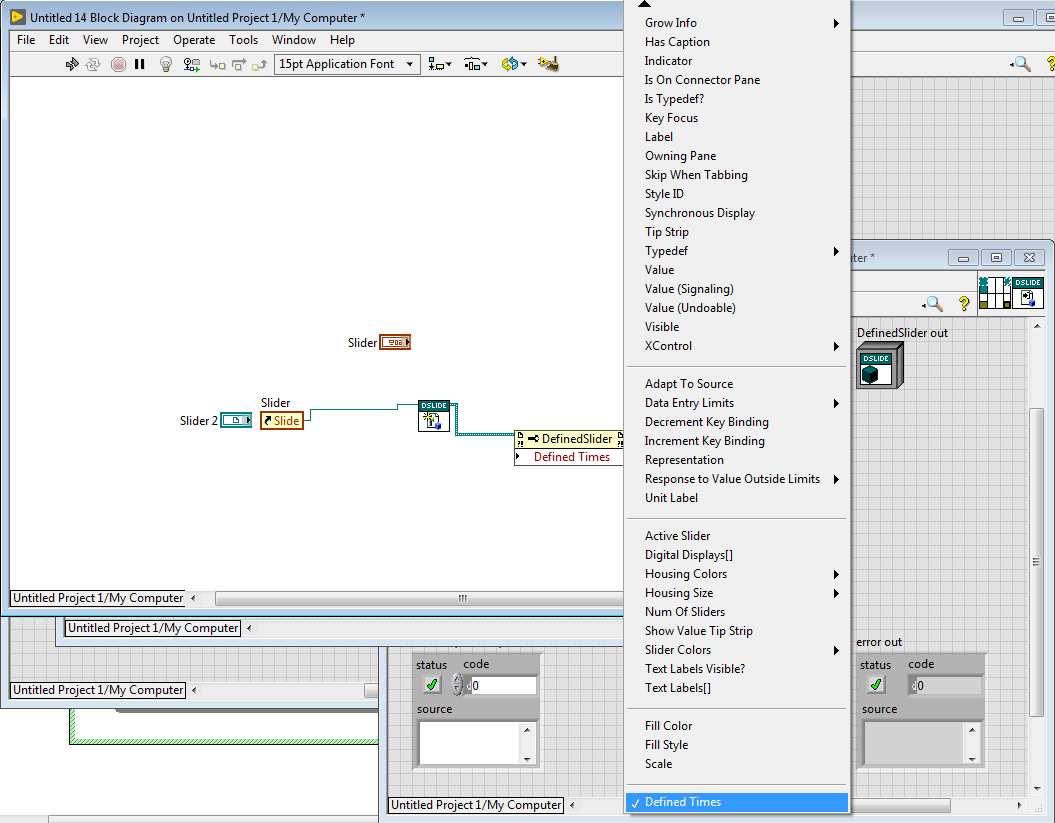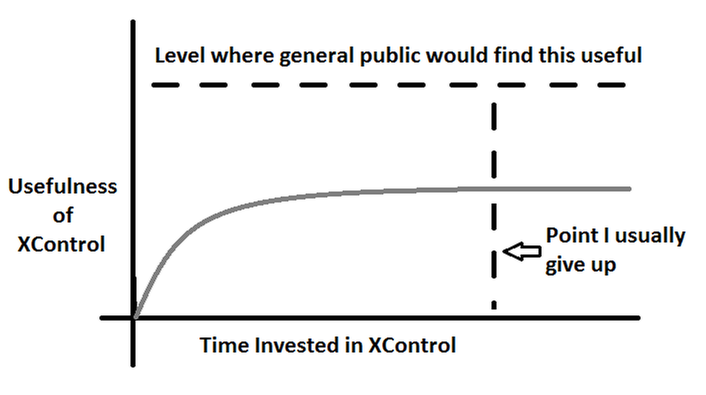-
Posts
3,450 -
Joined
-
Last visited
-
Days Won
294
Content Type
Profiles
Forums
Downloads
Gallery
Everything posted by hooovahh
-

Load Warnings When Building
hooovahh replied to martin_g's topic in Application Builder, Installers and code distribution
That is odd. I've been getting the same warnings for a long time now but my EXEs are build just fine and work as expected after hitting Ignore a few times. -
I'd disable PC sleeping and hibernation, disable power management, or set it to performance, and make sure USB ports aren't being put to sleep for whatever reason. Does this happen on all USB ports? Is this through a hub? Beyond that do you have any odd software running that might be scanning for USB devices? Some employers install software to lock down the PC and it could be interacting with it in a weird way.
-

An Extensible, Object-Oriented Alternative to XControls
hooovahh replied to The Q's topic in User Interface
I'm pretty sure the item selection in that tree means nothing, and setting it to -1 and disabling it might be the best option so not to confuse the user. All that matters is what items are selected with the checkbox. And even the checkbox acts like a radio button where only one item can be selected at a time. You can of course have multiple controls in a QControl, but it will only inherit from one class. -
As far as I know it is still happening. As usual we are a bit behind in the planning but as of right now it is still on, details to be posted when we have them.
-

Getting a ref to a clone VI inherently unsafe?
hooovahh replied to David Boyd's topic in Application Design & Architecture
I asked a similar question a while ago and Dr. Powell chimed in with what he believes it means. EDIT: Oh and a thread where AQ explains that having a clone reference doesn't keep the main VI from leaving memory. If it does it will close the clone references that you still have a handle on and can cause crashy. -

exec System Exec - not possible to recognize program or batch file
hooovahh replied to Dawid's topic in LabVIEW General
I just tried with another command that is in the system folder which is "dir" here is the command line string value I used: cmd /c dir "C:\Example Project" /w This was with the Working Directory being empty.- 11 replies
-
- application
- executable
-
(and 1 more)
Tagged with:
-
Just for others worried about CLA-R, be sure and look into the Recertify by Points, that Fab mentioned earlier. The CLA was so hard and I barely passed and never want to do it again. Luckily I'm certified until 2023, and already have some points towards certifying again. I realize not everyone wants to put in the time into getting points, and some don't have enough time to get them before certification expires. But if you have a local LabVIEW user group in your area you get 5 points for attending and 10 for presenting. You also get 15 points for participating in an NI beta. This means if you participate in 2 LabVIEW betas, and attend 4 user group meetings a year, you'll have enough points to recertify in 2 years. But of course valid criticism of NI's recertification is welcome.
-

[CR] Polymorphic VI Editor v1.0.1 LV2011
hooovahh replied to Ton Plomp's topic in Code Repository (Certified)
Is the file read only? Or protected in some way in the file system? -
And here are a few more links with examples from LAVA.
-

Set a default path when clicking path browse
hooovahh replied to Neil Pate's topic in User Interface
Only if you are okay with wiping away all other setting from LabVIEW. I prefer a package method which edits my LabVIEW.ini leaving the things there that the user or base install has set. It adds some QuickDrop shortcuts for instance, but if those shortcuts are already taken (because of user preferences) then it leaves them. On uninstall of the package it removes these shortcuts, but only if they were installed in the first place. -
I messaged Michael.
-
I don't think XNodes would help with this. XNodes are great for making a single thing on the block diagram do different things and encapsulate functionality in it. But there is no front panel connection with an XNode. The best you could do is maybe make an XNode, that internally links to a control reference on the FP. You'd still have the normal control terminal on the block diagram because I don't know of a way to make the control terminal itself invisible. If I could then then that would be a solution, but likely full of hacks and who knows if it actually would work well. And then you'd be dealing with a technology NI isn't interested in making more public. If QControls did have an XNode component, and it could essentially replace the native terminals and references, then I'd suspect NI would be less interested in making it part of the LabVIEW core. One nice thing about QControls today is how it is normal pure G, which as you mentioned might be why it has a hope for being ported to NXG.
-
Okay to be fair, QControls don't actually extend the VI Server tree, but from a developers perspective the outcome is the same, or close enough to not matter. You drop a property node, and you get get access to all the same things you're used to, and the new things. It looks like a duck, but might not be a duck. I can see why code changes in one place effecting the other can be weird, and for that I can think of a few ideas that are probably terrible. I haven't used them extensively yet, just working on a few ideas, but since it solves so many of my XControl problems, and adds just a couple problems of its self, I'm okay with it. I too wouldn't be surprised if NI doesn't invest in XControls, or an alternative. But then again for current LabVIEW I didn't expect that to get any better anyway.
-
You are incorrect they do and it is amazing. Here is a slider that I made into a QControl and I have all the normal slider stuff, but then have the extra stuff I added. It isn't perfect, like you can see the "Scale" normally opens up another submenu but in this case it just returns a reference, but with this you can then do the same stuff. Or you can just reference the original control instead of this class and do things exactly like you always have but you won't have the new items.
-
I just started down the rabbit hole of making a new XControl recently. Oh man such a pain. Here is a little graph I made complaining about the XControl creation process, and the time needed to make something useful. Any alternative is appreciated.
-
No. For the transparent-ness I customized the control in the control editor, moved the cells a little to reveal the back which was a shade of grey. I colored it transparent, then moved the cells back to where they were, then painted the white cells transparent. For the glyphs, if you have an INI key you get a right click menu on MCLB that is you Enable Glyphs In All Cells, I think the INI is EnableSecretPopups=True. Then you can enable it for any MCLB, and I think tree. It also gives other menus like having parts of a button move or grow with a button as it is resized.
-
Attached is an updated one with classic and modern MCLB, transparent cells, and glyphs in all cells. MCLB Symbols In All Columns Transparent.vi
-
Here is a Classic MCLB which can have its cells be transparent, and have symbols in all columns. System controls can't be colored, and the modern one I couldn't get to be transparent. It might be possible but the classic was easy. MCLB Symbols In All Columns Transparent.vi
-

Development Env packager
hooovahh replied to 0_o's topic in Application Builder, Installers and code distribution
Why is this a problem? So I make a VIPC with all packages I want in it cause I have pro. I double click this file, pick my LabVIEW version, a prompt then comes up for licensing and I accept all and then it installs all the packages. If you don't have pro you can still go to File >> Open Package File(s), select all the packages, then click Add and Install Packages, and have the same process. It isn't a "one click" install but after the install starts installing the first package you can walk away and come back after all the rest are done. I also have a package for editing LabVIEW.ini functions, editing QuickDrop, adding Right-Click, adding Tools Menu items, adding Help documentation (found in the Help menu in LabVIEW), etc. One thing I haven't done yet but I bet you could do, is make a package that calls into the NIPM API and installs NI run-times or toolkits as needed. It really depends on the amount of effort you want to put into it but I bet you could automate a lot of the process. Still I don't find it takes all day to setup a machine so I'm not sure I'd go through the trouble. The NI Web Install is already pretty good where you select the NI products, and NI drivers to install at the start and then it installs them without having to prompt again. For me all that is then needed after this is to install the VIPC I mentioned earlier. -
Yeah this is neat and useful...how much of this black magic is built into LabVIEW and how much did you develop?
-

How do I open the right-click menu when I can't click the object?
hooovahh replied to Sparkette's topic in User Interface
Oh come on it was there in 2009...but I can't remember if there were functions or just shortcut support. In either case in that thread I linked, I provided a way of invoking it through the Tools menu since most of the good shortcuts have been taken. -

How do I open the right-click menu when I can't click the object?
hooovahh replied to Sparkette's topic in User Interface
2018 SP1 F3. Edit: I think I might be getting it, I didn't set the owner properly. -

How do I open the right-click menu when I can't click the object?
hooovahh replied to Sparkette's topic in User Interface
Wait, also how do we copy these? I used the invoke node Move, with Duplicate set to True, but the object it creates has a 2px size not 0px. -

How do I open the right-click menu when I can't click the object?
hooovahh replied to Sparkette's topic in User Interface
Oh I just thought of something that might help. Here is a splitter manager utility which helps with panes and splitters. It can be invoked with QuickDrop and then can do things like set the color, position, and sizing behavior of panes. -

How do I open the right-click menu when I can't click the object?
hooovahh replied to Sparkette's topic in User Interface
Here is a small and borderless picture frame, along with smaller array. https://forums.ni.com/t5/LabVIEW/One-pixel-frame-for-picture-control/m-p/3716581#M1046089






